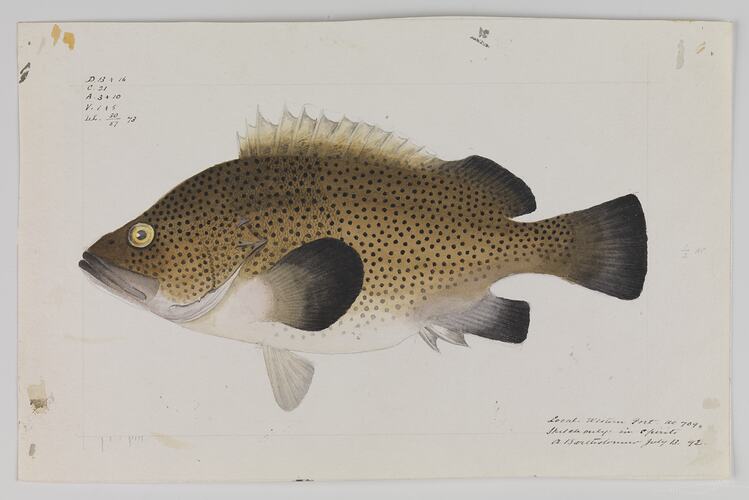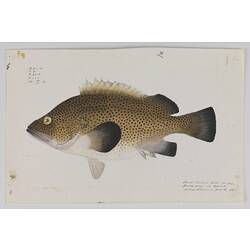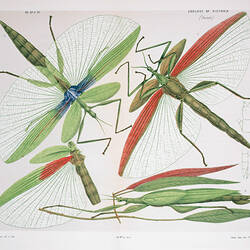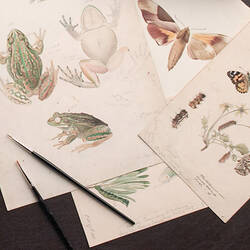Summary
Watercolour illustration of an Eastern Wirrah, Acanthistius ocellatus, from Western Port, July 1892, by Arthur Bartholomew, commissioned by Sir Frederick McCoy, first Director of the National Museum of Victoriah. This illustration and the specimen on which it is based (NMV A 7967, in the Ichthyology Research Collection at the Museum), represents to most westerly known distribution of the species,
The illustration forms part of the much larger Prodromus Collection. Many of the original illustrations in the collection informed the production of the two volume work 'The Prodromus of the Zoology of Victoria' which was Museum Victoria's first major publication from 1878. The Prodromus project followed a popular formula of the time, seeking to identify and classify the natural wonders of the 'new world'.
For more than 40 years, McCoy brought specimens to Bartholomew observe specifically for illustrations such as this Eastern Wirra. The laboratory was an environment where preserved specimens from all parts of Victoria were documented. Live animals were also nurtured here, enabling observation at a more considered pace. Responsibility for living specimens fell primarily to Arthur Bartholomew, Frederick McCoy's lecture room assistant. At any one time he maintained an assortment of aquaria and Wardian cases (portable greenhouse-type structures) to support a variety of fish, frogs, reptiles, insects and molluscs. Bartholomew was methodical and the quality of illustrations was both consistent and flawless. Bartholomew would first describe their form with fine pencil lines, before building up overlapping washes of watercolour and eventually adding glazes of varnish and gum Arabic. At last he would capture the colour saturation and level of sheen in each part of the specimen, achieving a subtle three-dimensionality reproducing both likeness and texture.
Publications such as the Prodromus reached a peak in popularity with the work of John Gould in England and the earlier work of James Audobon in America. In Australia, many professional and amateur publications, including Aldine's systematic studies of the colonies and Louise Anne Meredith's Bush Friends From Tasmania, contributed to the genre.The publication of the Prodromus was an enormous undertaking, utilising the work of numerous artists, collectors, lithographers and publishers, over an extended period of time. McCoy died without completing his systematic study, but even at the time few believed that 'any of us will live to witness the completion of the work, if the entire Fauna of Victoria is to be illustrated.'Although costly in both financial and professional terms, it was met with critical acclaim and wide popular support. Financial battles were waged and lost by McCoy, but ultimately the Prodromus has stood the test of time and remains one of Museum Victoria's finest publications.
Description of Content
Eastern Wirra, Acanthistius ocellatus by Arthur Bartholomew. Drawing D709, pencil and watercolour on paper, 13 July 1892, 17cm x 26cm. Drawing commissioned by Frederick McCoy as part of his zoological research.
More Information
-
Collection Names
-
Collecting Areas
-
Artist
-
Drawing Number
709
-
State
Illustration
-
Primary Inscriptions
Local. Western Port. No 709 / Sketch only. in spirits / A Bartholomew
-
Secondary Inscriptions
D.13+16 / C.21 / A.3+10 / V.1+5 / L.L.30/57 73
-
Classification
-
Taxon Name
-
Author and date of publication
(Günther, 1859)
-
Preferred Common name
Eastern Wirrah
-
Kingdom
-
Phylum
-
Subphylum
-
Superclass
-
Class
-
Order
-
Family
-
Genus
-
Species Name
ocellatus
-
Identified By
Dianne J. Bray - Museums Victoria
-
Date Identified
2004
-
Category
-
Discipline
-
Type of item
-
Overall Dimensions
26 cm (Width), 17 cm (Height)



